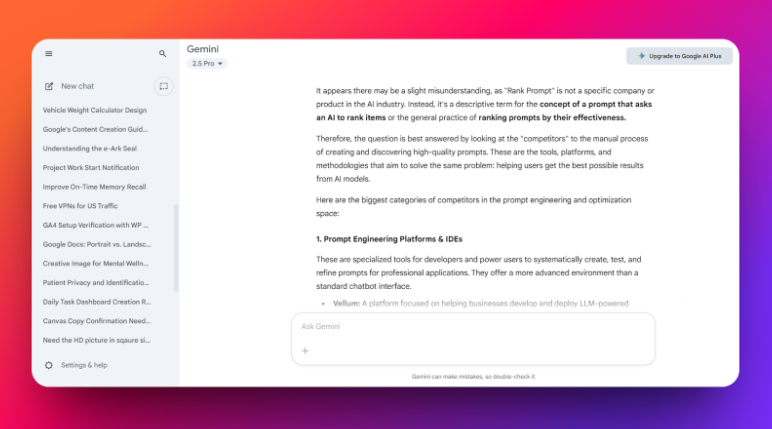Key Takeaways:
- AI answers now lead results and cite sources (Google AO, Copilot, Brave, Perplexity), so visibility = being cited, not just ranked.
- Track four metrics: presence rate, citation share, prominence (primary vs. secondary), and consensus (cited across 3+ engines).
- Build a focused 100–300 query list; for each engine/query, log every cited domain and its prominence.
- Rank competitors with a simple Citation Visibility Score (CVS) using engine + prominence weights.
- Win inclusion: answer-first intros, short FAQ with schema, fresh updates, and quotable stats/primary sources.
Search doesn’t start with blue links anymore it starts with an AI answer and a handful of citations. Google’s AI Overviews now run in 200+ countries and 40+ languages, putting source links inside the summary itself and changing what “visibility” means. That’s the new front row your brand has to win.
Early data shows behavior is shifting with it. When an AI summary appears, users click fewer links overall, according to Pew’s 2025 analysis; one independent study measured a 34.5% drop in clicks for top-ranking pages when AI Overviews show. Translation: ranking first isn’t enough if you’re not a cited source.
And it’s not just search pages AI is moving into the browser itself. Perplexity’s Comet, now available free, brings answer-first research to every page you visit, pushing citations beyond SERPs and into the browsing experience. Winning today means analyzing who gets cited across AO, Copilot, Brave, and AI browsers and then optimizing to earn those citations consistently.
How to analyze competitor presence in AI search
1) Build a focused query set
Make a list of 100 to 300 searches people use. Cover five types: learn, compare, buy, brand, and fix. Remove repeats so each search appears only once, and keep a separate list for each country or language.
Sort the list by simple importance. Put the searches that help you win customers or answer common problems at the top. Keep everything short, clear, and easy to scan.
Review the list every month. Add new searches you see in support or sales chats and drop ones that no longer matter. This gives you a steady, focused set you can track over time.
2) Set a consistent sampling plan
Run the audit the same week every month so results are comparable. If answers in your niche jump around, add a small mid-month spot check on 10 to 20 percent of your queries to catch big swings early.
Test on desktop and on mobile. Use a clean private window with no add-ons. Keep the same settings every time and write down the basics for each run like locale, device, and browser version.
If you work in more than one country or language, treat each one as its own study. Do not stay logged in, clear your cache, and use the same IP region for each locale. Record the run date and the week label so your dashboard lines up month to month.
3) Capture results per engine & query
Check each query in four places: Google AI Overviews, Bing Copilot, Brave Summarizer, and Perplexity Comet. For every engine, first note if an AI answer shows or not. If it does not show, still record that result so you see the full picture.
If an AI answer appears, add one line for every source it cites. Write the main site name only, not the subdomain. Mark how prominent the link is using three simple levels: P1 for the top link, P2 for an inline or secondary link, P3 for anything tucked away. Also note the exact position number in the answer.
Tag the type of answer so patterns are easy to spot. Use clear tags like definition, how to, comparison, best of, pricing, troubleshooting, review summary, or other. Keep a simple sheet with these fields: run date, week label, locale, device, engine, query, query weight, AI answer yes or no, answer type, total citations, domain, page url, prominence tier, position number, and a flag for whether the page also shows in the classic results.
4) Compute the core metrics
Compute four core metrics for each engine and for your whole set. Presence rate shows how often your site is cited when an AI answer appears. Citation share shows how many of all citations belong to you. These two tell you if you show up and how big your slice is.
Look at prominence next. Track how many of your placements are primary, secondary, or peripheral. Aim to grow primary spots because they are seen first and usually drive the most trust and clicks.
Finally, check consensus. List the domains that appear across three or more engines for the same topics. These are the trusted sources to benchmark and learn from. Slice all metrics by topic so you can see where to focus your next content updates.
5) Diagnose why winners win
Start by looking at the winning pages. Most open with a short answer at the top, then use clear subheadings and a small FAQ. When the topic is a comparison, they use a simple table so the key differences are easy to copy and cite.
Check how fresh the page is and what changed. Good pages show an update on line and add real edits like new stats or a new step, not just a new date. They also link to primary sources and include short facts that are easy to quote.
Find your gaps by topic. If you lose on comparisons, publish a clean side by side page with a clear method. If troubleshooting is weak, add step by step fixes. Example: a rival wins because they refreshed their how to page last week and added two government data links and a three row table. Match that structure and update rhythm on your own page.
How to tune content for each engine?
Google – AI Overviews
- Make the “lead extractable.” Open with a 2–3 sentence answer that defines the term, gives the why, and names the key factors; keep sentences under ~22–25 words and avoid pronoun chains so the summary can quote cleanly.
- Prioritize consensus-building links. Cite 2–4 primary or standards-level sources (docs, specs, datasets) early; use inline citations near claims, not a long “references” footer.
- Design for prominent links. Add a short FAQ (schema), a comparison table (where relevant), and labeled steps; keep H2s descriptive (“What is…”, “How it works…”, “Pros vs cons…”) and trim paragraphs to ~80–100 words.
Bing – Copilot Search
- Grounding-friendly structure. Use concise subheadings and numbered steps; split concepts into self-contained paragraphs that can be lifted without context.
- Dual win with classic results. Tighten titles/meta so the same page competes in organic results while being clean enough to cite in the Copilot box.
- Evidence first. Where you make claims, place the source link immediately after the claim; prefer authoritative domains and original data over tertiary blogs.
Perplexity – Comet
- Out-of-context clarity. Assume readers see your text in a side panel; front-load definitions and outcomes so snippets make sense without the intro.
- Tables and micro-benchmarks. Provide compact comparison tables and method notes (what was measured, dataset, date) so Comet can attribute precise facts.
- Link hygiene. Use stable URLs, canonical tags, and clear figure captions; keep alt text meaningful so figures can be referenced accurately.
Metrics & Reporting
Core KPIs (by engine, by topic, overall)
- Presence rate shows how often you’re cited when an AI answer appears. Grow it monthly; investigate any drop of 5 points or more.
- Citation share is your citations out of all citations. Track by engine and topic; win share on your most valuable topics.
- Prominence mix shows primary vs secondary vs minor placements. Push for more primary on key pages.
- Consensus overlap lists domains cited by 3 or more engines. Study these trusted sites and learn from their structure.
- Engine spread shows your visibility across Google AO, Copilot, Brave, and Perplexity. Use it to target fixes where you’re weak.
Dashboard views to build
- Leaderboard: Top 10 domains by CVS (overall & by topic).
- Waterfall: MoM change drivers (presence vs. prominence vs. engine weights).
- Heatmap: Queries × Engines, cells show your prominence (P1/P2/P3/–).
- Consensus matrix: Domains vs. engines; highlight those present in 3–4 engines.
- Cluster report: For each topic (pricing, how-to, comparisons, troubleshooting), show your Presence, Share, and P1%.
KPIs that need attention
- Presence rate drops by more than five points on any engine
- Primary placements fall below 25 percent on a key topic
- A new competitor shows up across three or more engines
- You look strong on one engine but weak on another focus fixes on the weak one
Reporting cadence & notes
- Freeze inputs (query set, weights, locale/device) for at least one quarter to get clean trends.
- Include a one-slide Change Log: pages refreshed, new comparisons/FAQs, new benchmarks published.
- Pair the dashboard with two actions per cluster.
Top 10 things to do
- Add a short answer at the top of your 50 most important pages. Say what it is, why it matters, and the result in two or three sentences.
- Add a small FAQ to those pages with three to five real questions and answers.
- Publish two or three clear comparison pages with a simple table and a fair method.
- Update pricing and alternatives pages. Add a date and a short change note. Link to official sources.
- Create one small benchmark or dataset. Explain how you did it, show a table, and give one clear takeaway.
- Use the same heading pattern on every page and keep paragraphs short and easy to scan.
- Add HowTo or Article schema where it helps readers understand the steps or the content.
- Make pages easy to read on phones. Use clear fonts, good spacing, and fast load times.
- Put source links right after claims. Prefer official docs and standards.
- Set up a simple monthly check. Run your queries, calculate your visibility score, and set alerts for big drops.
How to set it up
Here is the best approach to set it up.
Collection
Run your query list in RankPrompt across Google AI Overviews, Copilot, Brave, and Perplexity Comet. For each query, note if an AI answer appears, which sites are cited, how prominent each citation is, the exact position number, and the type of answer. Use the main site name only, not subdomains.
Schema
Keep one simple table with these columns: run date, week label, locale, device, engine, query, query weight, AI answer yes or no, answer type, total citations, domain, page URL, prominence level, position number, and a flag for whether it also shows in classic results.
Scoring
Give each row a small score using engine weight, prominence weight, one over duplicate count, and query weight. Then add up scores by domain, by topic, and by engine to see who leads.
Dashboards and cadence
Build a few views in RankPrompt: a top domains list, trends for presence and citation share, a chart for prominence levels, and a simple matrix that shows overlap across engines. Keep the same queries, weights, and settings for a full quarter. Run the full set once a month and do a small spot check mid month. End each report with two clear actions per topic, like add FAQ schema to key pages or publish a side by side comparison.
FAQs
What exactly counts as a “citation” in AI answers?
Any linked source surfaced inside the AI summary card/panel (e.g., “prominent links” in Google AO, inline references in Brave, sources listed under Copilot’s grounded answer, or the side-panel references in Perplexity/Comet). Track the domain (eTLD+1), the link’s position, and its prominence tier.
Do branded queries inflate performance?
Yes. Brand terms often boost Presence and P1 rates. Always slice reports into brand vs. non-brand to understand true competitive standing on neutral queries.
How big should our query set be?
100–300 total is the sweet spot for monthly cadence: enough to stabilize metrics, small enough to review manually if needed. Use topic quotas (e.g., 25% comparisons, 25% informational) so clusters are comparable month over month.
How stable are AI answers across days/locales/devices?
They fluctuate more than classic results. Control variation by fixing locale, device mix, and run window (same week monthly). Add a 20% spot check mid-month to catch shifts without doubling effort.
Is schema mandatory to get cited?
Not mandatory, but FAQ/HowTo/Article schema improves extractability and consistency. It helps engines identify concise answers, steps, and Q&A blocks that map well to summary formats.
What content types most often win P1 placements?
Pages with a clear answer-first intro, a short FAQ, and quotable facts/tables especially comparisons (“X vs Y”), troubleshooting steps, and crisp definitions with primary citations.
How do we tie this to business impact?
Annotate key pages with UTMs in outbound references from AI cards where possible, and monitor organic brand searches, direct traffic, and assisted conversions after content refreshes. Track MoM lifts where Presence and P1 share improved.
What’s a good first-month goal?
Baseline everything, then target +5pp Presence rate and +10–15% CVS in one priority cluster by shipping answer-first intros, FAQ schema on top URLs, and 2–3 comparison pages.




